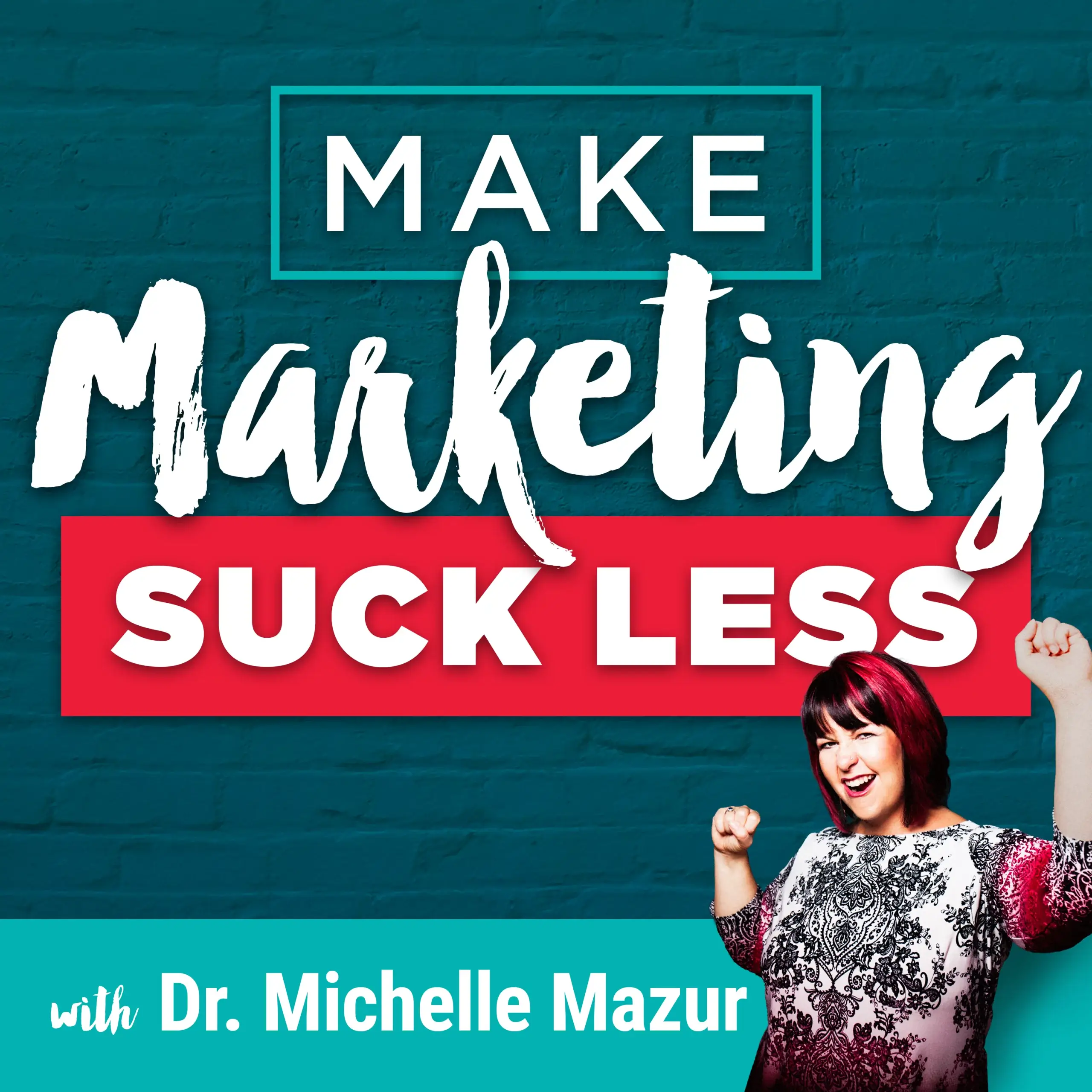Make Marketing Suck Less
Cultivating a Mindset that Allows You to Make Your Impact
By Michelle Mazur > February 5, 2019
Filed Under Podcast

If we let our minds run free, it goes places that we don't necessarily need to go to and then all of a sudden you find yourself stressed out. Having anxiety in the middle of the night or sometimes even in the middle of the day for no apparent reason.
To do the change making work that you and I want to do to create the impact that we want to make, we have to cultivate our mindset.
On this episode, learn how to consciously and deliberately choose your thoughts that help you reach your impact goals.
Table of Contents
Tune into the Audio:
Do you ever feel like your mind isn't your friend?
You wake up at 2:13 am, wander to the bathroom, and BAM, all of the sudden you're replaying a conversation that you had with a client. You're second-guessing what you said. You're wondering if you're doing a good enough job for them and you're thinking about how they might not think you're very good at what you're doing.
Or BAM! You're worrying about a bill that's due in a couple of months and you're trying to figure out how you're going to pay for it.
Our minds can be like a runaway train if we let it.
If we let our minds run free, it goes places that we don't necessarily need to go to and then all of a sudden you find yourself stressed out. Having anxiety in the middle of the night or sometimes even in the middle of the day for no apparent reason.
To do the change making work that you and I want to do to create the impact that we want to make, we have to cultivate our mindset. You need to consciously and deliberately choose your thoughts that help you reach your impact goals.
And I've realized a while ago that my mind left unchecked is so not my friend and having a positive mindset has nothing to do with being 100% happy all of the time. It does have to do with making a choice about what you're thinking and how those thoughts make you feel.
Working on my own mindset was one of my personal projects for 2019 because one of my major themes is to show myself more love and compassion and that means making friends with my mind.
I was so excited to see that Mel Robbins kicked off this year with her Mindset Reset program. So of course I jumped right into it.
Y'all know how I love Mel Robbins. I wanted to share four of the tools from this program that have made the biggest difference to me and my mindset.
And hey, if you're interested in resetting your mind, it's not too late. Mel Robbins is doing this program for free and you can still get access to all of the videos if you go to melrobbins.com/mindsetreset.
Tool #1: Visualization that Actually Works
Here we go, tool number one, visualization that actually works.
For a long time, I've struggled with visualization and I believe it's because I was fed a myth about what visualization needs to be like. It needs to be meditation and 15 to 30 minutes long. You have to be wandering by a creek or in a meadow or in a field. And it goes on forever.
I've always struggled with consistent visualization because I don't have time to visualize that long. Even my meditations in the morning are maybe five minutes.
Honestly, sometimes I have a hard time picturing what my goal realized looks like. Like what does success look like? So how the heck I'm going to focus on it for that long?
I've had success with visualization, visualizing a speech. I can take myself through my entire speech and visualize the audience responding well, laughing, and participating because I've been in that situation before.
But for me, something that hasn't happened yet, like hitting a large financial goal or selling 5,000 copies of the 3 Word Rebellion book, which hey, that's coming out on February 26th. I have not done those things YET so I can't see it.
Mel Robbins helped me reframe this.
Visualization only needs to take 30 seconds of your time. Or as Mel says, “don't your dreams deserve 30 seconds?” Yes, yes they do.
She suggests picturing a scene of what the goal or the accomplishment you have in mind looks like and then think about how you feel. So for instance, selling 5,000 copies of the 3 Word Rebellion book. In my head, when I visualize, I picture myself at the end of a speaking gig, sitting at a table with a stack of the books and there is a line of people waiting for me to sign their copy of the book and that feels amazing. I feel the difference that I'm making, the ripple effect of change that I'm creating. It feels like I've accomplished something so huge and good.
So that's a great way for me to see my goal! For goals that I have a harder time visualizing, what I am doing is I actually invite Mel into my visualization. She shows me that I have accomplished this goal, she tells me what a badass I am and gives me high fives. I feel great and I feel so proud of myself for accomplishing this goal that I didn't think I could do.
It's just so helpful to invite someone into my visualization that I can have a conversation with instead of trying to visualize the exact scene.
When you're going after a big goal, visualize a scene of what success will look like and how it feels for you.
Even if you're having a tough time visualizing the goal, invite a coach or mentor into your visualization and celebrate with them achieving that goal because Mel is right, our dreams do deserve 30 seconds.
Tool #2: Productive Worry vs. Nonproductive Worry
The second tool that the Mindset Reset program has given to me is showing me the difference between productive worry versus nonproductive worry.
I'm a worrier. I've talked about this when I had the author, Amber Rae, on the show to talk about her book, Choose Wonder Over Worry (which is also a great 3 Word Rebellion).
I'm always looking for strategies to deal with how much I find myself worrying. Worrying was pretty much passed on to me from my mom. My mom was a complete worrier and now I have that habit as well.
So I'm one of those people who start worrying about the most random things in the middle of the night. I worry about money, my clients, my cats. That awkward conversation I had with a friend and did I say the right thing.
What has been helpful is that Mel makes a distinction between productive worry and nonproductive worry.
Productive worry you can do something about. There's an action you can take.
For instance, if I've just left the house and then all of a sudden I'm worrying that my cats might not have enough food while I'm gone.
Hey, I can do something about that. I can go back to the house and I can check the food and the water dish. Give them more food and then leave. That's productive worrying.
However, if I wake up in the middle of the night worrying about a difficult conversation that I had with a friend and how is that going to impact our friendship. And I'm replaying what I should have said instead of what I did say a million times. That's unproductive because there's nothing I can take immediate action on. Trust me, none of my friends want me calling them at 4:00 AM to chat about something I might have said that ticked them off.
However, being able to classify my worry into productive or nonproductive worry allows me to disrupt the worry frenzy that my brain loves to feed on in the middle of the night or sometimes in the middle of the day.
Then that sets me up for this next tool.
Tool #3: Think This Not That
So tool number three is thinking this, not that, and it is a way to reframe unhelpful thoughts.
Let me give you an example. A couple of weeks ago I booked a last minute speaking gig. The gig was maybe nine days away and I had to prepare a speech, customize it for that audience. During that week I also had 20 client calls and sales consultations.
So looking at my schedule, I immediately felt I don't have enough time. That was the thought that was going through my head. I don't have enough time, I don't have enough time, I don't have enough time.
And it made me feel overwhelmed and anxious and I didn't know what to do next. So what I did is I stopped and I reframed that thought.
My mantra for that week became, there is more than enough time, there's more than enough time to talk to my clients to have really good and exciting sales conversations and to prepare for the speech.
Do you know what happened? Some of my calls that week got moved around and that created more space and more time. I decided to get up 30 minutes earlier so that I could work on the speech before my client days.
It was remarkable because, at the end of every day that I was chanting, there is more than enough time. I would get everything done on my to-do list. So thinking that I had more than enough time felt so good, it got me into action and it was less stressful.
When you find yourself stuck in a negative, unproductive thought loop, you can disrupt that and deliberately choose a different thought that serves you so that you can accomplish what needs to be done.
Choose a different thought and that helps you stay on track.
Tool #4: Assume Positive Intent
The fourth and final tool that Mel has given us that I absolutely love is assuming positive intent.
Imagine you're up for a big speaking gig. Negotiations are going well. You feel sure that you're going to land this gig. You send the email with the contract and then nothing.
You hear nothing back and when that happens, our brain starts making up stories for why this is happening and it's usually a negative story. Something like, “Hey, what a jerk. I can't believe they wasted my time like that. How dare they disrespect me in this way?”
We assume the reason why we didn't hear back from a speaking gig or from a potential client or the reason someone cut us off in traffic was personal.
They're being a jerk. They're malicious in some way. But those thoughts of being slighted, they do one thing and one thing only. They torture you and make you feel like crap.
So what if you assumed positive intent?
Maybe the other person just got busy or they were called away on another project or they got a cold all of a sudden, and they weren't able to get back to you.
Or the person that cut you off in traffic was late for their very first day at work or their kid is sick and they're trying to rush to get to the school.
Most of the stories we tell ourselves about why people do what they do have nothing to do with us. So choose positive intent. Don't assume ill will tell yourself an alternative story.
Mindset Reset has been a game changer for me to start the new year off, right.
No matter what has come at me and trust me, there have been a few things that have thrown me off my game and I'll probably be talking about that in upcoming episodes. I have been able to navigate those.
I've been able to banish worry thoughts, reframe what I was thinking, choose a different thought and assume positive intent.
Honestly, since I've been visualizing, I can't think of a better way to start my day then spending a minute or two visualizing my dreams coming true. It just brings me joy.
Since I've been doing the work, I've noticed I've been happier and more positive. I worry less and I feel like I'm more in flow.
Just as a reminder, you can access these trainings. I'm not an affiliate for this. I'm just a believer in what she's doing and I wanted to share these tools because I think our mindset is the key to accomplishing the impact that we want to make as change makers.
So you can still get those at MelRobbins.com/MindsetReset.
When you are a changemaker who has big, audacious goals, it's important to get your mindset in check to make it happen so that you are prepared for the wins and the losses that happen on your journey.
Create Your One-of-a-Kind Message
Your 3 Word Rebellion is the Key to Growing Your Business & Impact






